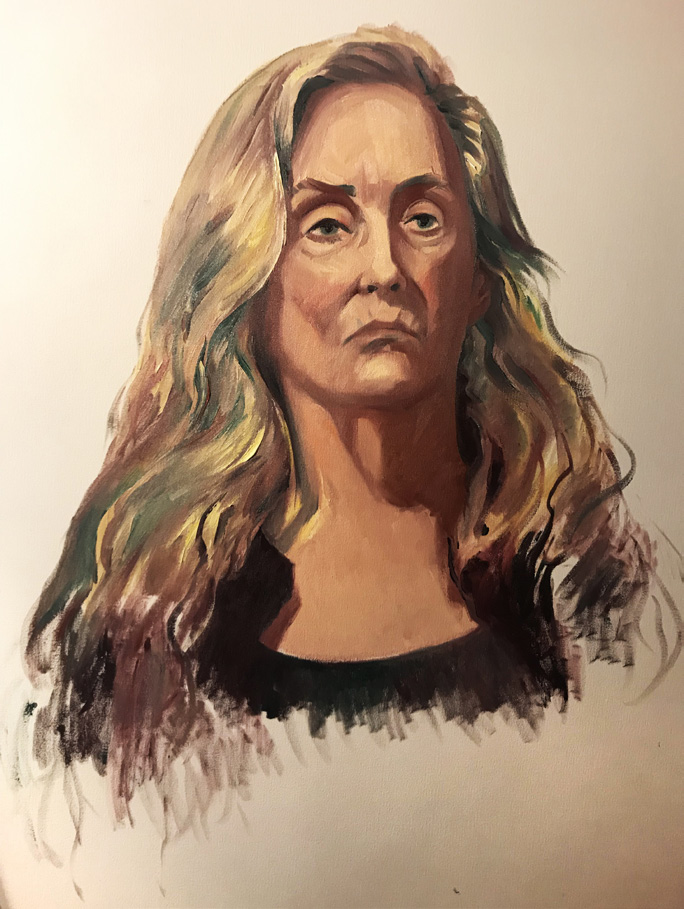
In progress in December of 2021.
About five years ago I became obsessed with a painting I had always loved, Théodore Géricault’s The Raft of the Medusa.The painting is 16 by 23½ feet. The subject of the painting is a shipwreck where the survivors were brought to hopelessness and beyond by their ordeal of fighting for their lives on a raft in the Atlantic, until they spotted a ship and were eventually rescued. Only fifteen of them were still alive.
I met this painting in 1967 when my first husband and I traveled in Europe, and it struck me to the core. You experience the painting as if it were a film because you walk along it… it is not moving, but you are moving. It is heart breaking and yet hopeful. Composed in two overlapping triangles. the one on the right is optimistic, the one on the left decimating. I never forgot this masterpiece. In 2006 when I had a fellowship to paint in Italy for six weeks, I made my pilgrimage again to Paris, to the Louvre, where this phenomenon lives. It has changed my life.
That was a long time ago and I’ve never forgotten the impact of Géricault having used a current event, a newspaper story of his time, as inspiration to create a profoundly universal statement about suffering, and the overcoming of suffering with hope.
Many years later, when we were experiencing the horrors of the Syrian war in the media, I decided that I had to do something. Since I have no money to send and am too old to fight a war, I knew I had to paint about the war. With the help of two friends, I stretched a 9½ by 16 foot canvas on the wall of my studio. I Gessoed it three times, sanding it in between each layer. I was going to paint about the Syrian refugees, as an homage to The Raft of the Medusa. I researched images for a year and made many drawings for the painting, but it was going to involve a lot of blood and violence. I have three grandchildren who stay with me quite often, and at that time they were around five years old. I talked about it with them, and they were going to pose for the children in the painting. I had a number of other people who promised to pose for the painting. But, in the end I couldn’t do it. I couldn’t have the children witness that slaughter up close.
After the decision, I was a bit lost. I had to ask myself, “what is most important to me?” I realized that it is our planet itself. If we continue to trash our world then we won’t have any place to live, and nothing else is really going to matter too much.
I’m not a painter of planets. I paint people. I paint self-portraits because I’m really just trying to figure out what it means to be a human being, so staring into my own eyes in the mirror is a useful place to start. It keeps me on track and has helped me to understand who I am, and where I am in the greater scheme of things, and through that to better understand other people. But I do love to paint and draw other people, even though I often get a lot of flak because I can only paint what I see, and sometimes that isn’t how the other person sees themselves. For my whole life I have only painted from life. I’ve always said that painting from a photograph doesn’t give me enough information. The magic of translating three-dimensional space onto a two- dimensional plane is what turns me on.
And, I really love tigers. I first fell in love with a Siberian tiger at the San Diego Zoo in the mid 1980’s, and I drew him until they kicked me out. He was behind a very thick piece of glass, sleeping in his cave. His head was around eighteen inches wide, and his body stretched out to around twelve feet long. He was only a foot and a half away from me as I sat on the floor drawing, and he would wake up periodically and stare into my eyes. He was the most magnificent creature I have ever experienced, and I never forgot him. I’ve done a lot of self-portraits with tigers since then.
I became aware that this painting was going to be about the fact that the Sumatran tigers who live in the Sumatran Rainforest are so endangered that there are possibly only five hundred of them left in the wild, and their habitat is decreasing, being erased by the moment, to make toilet paper and palm oil for cookies and chips. So, I had to make a painting about the tigers. But, how do you get hope into this equation? Unlike in The Raft of the Medusa, there isn’t going to be a ship appearing on the horizon!
My grandson had the idea. I was still planning for my three grandchildren to be in the painting. My grandson said that they should each be carrying a tiger cub. So that’s what we did. They each got to choose the tiger cub they wanted to carry. I’m sitting in the middle, and I’m holding a paintbrush, and I’m painting the viewer, because this painting is really about you, the viewer. What are you going to do about this? What are we going to do about this? But, I’m trying to do something! And my grandchildren and I are all looking at the viewer, and I’m sitting with my arm around a big Siberian tiger. And, I had a roommate for the last couple of years, a good friend who is a magnificent specimen of a man, and he agreed to pose.

I’ve been working on this painting for a couple of years, since November of 2019, and it will take quite a few more months before it will be complete, but I have been envisioning that this spring, or at least by summer, hopefully the coronavirus will give us a break, and I can start to invite people to come and see the painting. A lot of people have been supporting me in this project, from near and far, as I’ve worked on it all through the pandemic. I’ve even sent images of it in all the stages of progress to a few select people who I can trust not to tell me how I can fix it!
My process is spiritual, and it takes as much time as it takes. I’ve been a working artist for seventy-four years because I’ve known that I was an artist since I was four. I
never wanted to do anything else. I was selling my paintings on our brownstone steps when I was five. And now I have seventy-eight years on the planet, so it’s easy to think of myself as a master, as I went through that stage. I think as a feminist it was very important to know that I wasn’t a student anymore, especially a student of male teachers, that I had become a master. I have taught a lot of adults and mentored a lot of artists, but now in order to do this work, I needed to admit that I didn’t know how to do it. It was very humbling.
As I said, I hate working from photographs. There just isn’t anywhere nearly enough information. And, I’m working from a million photographs, from a hand, a wrist, an ear, a tiger cub, a leaf, a cloud. It’s impossible, but I have to do it anyway! I became aware that it was a prayer state for me, a meditation. As the paint goes onto the canvas, one stroke at a time, I have to turn it entirely over to my higher power for guidance. That’s been my experience of painting for a very long time. I believe you hone your craft, you study as hard as you can, you try to become as good in your field as possible, and then, when it’s time to actually be involved in the creative miracle, you have to give it all up to a higher power, or at least that’s what I have to do, and that’s when the magic happens.
That’s when things surprise me and I can participate in a transcendent experience. Then when that happens, my viewer has a chance to experience something powerful, something way beyond anything I’m capable of. That’s the way I have found painting to be for a long time, but this painting is different. Because I have to work from photographs and not living beings, I have to beg my higher power to breath life into this work. I have had to find a new level of humility. That has been a struggle. I cannot afford to be cocky for one second or the work begins to look cliché.
I’ve been very engaged in this project and I’ve become aware that, not only do the tigers have to come to life, but my grandchildren have to be specifically who they are, and of course they’ve changed a lot in the last two years, so I’ve had to try to keep up with that and it’s challenging. But, it’s coming along. I can’t wait to share it, even as a work in progress. Wearing masks and trying to keep participation to a minimum at any one time, over time everyone can see it. It doesn’t translate very well in digital images. Too much is lost in the change in scale. And cameras all distort. But that will be the only way most people will ever experience it, which makes me sad. Luckily, there has been interest in the painting in “the flesh” as soon as it is finished!
Copyrights Sharon Wybrants, writing – re: Endangered Tigers painting





Leave a Comment